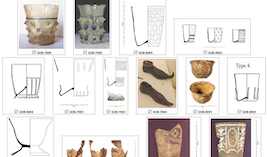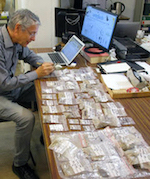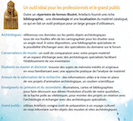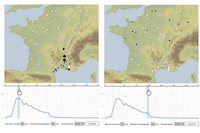Artefacts, an encyclopedia of objects accessible to everyone
- Published: Wednesday, 18 October 2023 14:28
- Written by Lucie Puyjalinet translated by M. Ataïde and M. Schmitt
- Hits: 876
The collaborative encyclopedia of archaeological objects, Artefacts, was created thanks to the work of Michel Feugère, archaeologist at the Lyon-based laboratory Archéologie et Archéométrie. Today, ArkéoTopia is committed to bringing this tool to the general public.
Michel Feugère: "Artefacts is like a house
where everyone adds a stone."
 Are you looking for the origin of a type of object, where it can be found, or simply a statuette of an antique character that interests you? This is possible thanks to Artefacts. This collaborative encyclopedia of objects is accessible to all online and is constantly evolving thanks to the museum curators, archaeologists and students who contribute to it. Thought up nearly thirty years ago, it now lists about 181,309 objects. Michel Feugère, archaeologist at the Lyon-based laboratory Archéologie et Archéométrie (Archaeology and Archeometry UMR 5138) is the founder. Today, with the participation of ArkeoTopia, he is presenting this tool to the general public.
Are you looking for the origin of a type of object, where it can be found, or simply a statuette of an antique character that interests you? This is possible thanks to Artefacts. This collaborative encyclopedia of objects is accessible to all online and is constantly evolving thanks to the museum curators, archaeologists and students who contribute to it. Thought up nearly thirty years ago, it now lists about 181,309 objects. Michel Feugère, archaeologist at the Lyon-based laboratory Archéologie et Archéométrie (Archaeology and Archeometry UMR 5138) is the founder. Today, with the participation of ArkeoTopia, he is presenting this tool to the general public.
Can you introduce yourself and your laboratory?
 Michel Feugère (MF): I studied literature, art history and archaeology in Lyon and then in Aix-en-Provence. I joined the CNRS in 1982 and I am still there. I work in the Archéologie et Archéométrie laboratory which has the specificity of being a laboratory of Human and Social Sciences, but practicing both archaeology and physico-chemical sciences, for the analysis of ceramics. Therefore, we are called Archéologie et Archéométrie because we are the heirs to a laboratory of physico-chemical sciences that was created to conduct ceramology in France and which then expanded. We are still involved in the analysis of ceramics; it is a particularly important part of the laboratory and we are also one of the very few platforms in France that does carbon 14 (14C) analyses. In archaeology, there are mainly teams of medieval archaeologists and two others who deal with archaeological finds: ceramics for one and objects for the other.
Michel Feugère (MF): I studied literature, art history and archaeology in Lyon and then in Aix-en-Provence. I joined the CNRS in 1982 and I am still there. I work in the Archéologie et Archéométrie laboratory which has the specificity of being a laboratory of Human and Social Sciences, but practicing both archaeology and physico-chemical sciences, for the analysis of ceramics. Therefore, we are called Archéologie et Archéométrie because we are the heirs to a laboratory of physico-chemical sciences that was created to conduct ceramology in France and which then expanded. We are still involved in the analysis of ceramics; it is a particularly important part of the laboratory and we are also one of the very few platforms in France that does carbon 14 (14C) analyses. In archaeology, there are mainly teams of medieval archaeologists and two others who deal with archaeological finds: ceramics for one and objects for the other.
How did your interest in objects come about?
MF: It was a bit of a chance encounter. When I was studying in Lyon, I had as a professor a researcher from the CNRS who specialized in antique bronzes and I wanted to work on that. It also meets demand in relation to archaeological excavations; the discipline needs researchers who deal with all categories of artifacts.
Is that what led you to create the Artefacts project?

Can you explain what Artefacts is?
MF: It is an encyclopedia. The rating system is not oriented to a particular region or time period. We are dedicated to covering everything people want to be able to put in. If someone is working on Iran of the 2nd millennium, they will be able to find objects from Iran of the 2nd millennium since the tool allows it. It is a classification and analysis tool.
Why this name?
MF: We had to find a short name for the Internet. An artifact is a tool fabricated by humans with a technique. It is in fact the definition of an object.
Does this answer a real need to list small objects?
 MF: Whether it is coins, ceramics or other types of objects, it is necessary to have reference bases. These objects ー we no longer say small objects because some are two meters long ー are distinct. Many specialized workshops have designed special types that were distributed throughout Europe. So, for archaeology, if we are too focused on a region or nation, it is difficult to understand. By necessity, an ambitious program was needed that could cover large regions and be international. By pooling the knowledge of widely dispersed specialists, each with their own approach based on their excavation experience, culture and training, we can have a much better understanding of the material than through separate publications. In addition, the mapping tool allows the processing of large masses of data, which is also necessary to study the distribution of materials, types, decors, etc. Artefacts is now perfectly in line with the needs of Big Data. This is the reason why we have set up this tool. Of course, this was done gradually over 30 years.
MF: Whether it is coins, ceramics or other types of objects, it is necessary to have reference bases. These objects ー we no longer say small objects because some are two meters long ー are distinct. Many specialized workshops have designed special types that were distributed throughout Europe. So, for archaeology, if we are too focused on a region or nation, it is difficult to understand. By necessity, an ambitious program was needed that could cover large regions and be international. By pooling the knowledge of widely dispersed specialists, each with their own approach based on their excavation experience, culture and training, we can have a much better understanding of the material than through separate publications. In addition, the mapping tool allows the processing of large masses of data, which is also necessary to study the distribution of materials, types, decors, etc. Artefacts is now perfectly in line with the needs of Big Data. This is the reason why we have set up this tool. Of course, this was done gradually over 30 years.
Are some periods less represented than others on Artefacts?
 MF: Yes, because Artefacts only progresses because of the people who participate in it. That is why, for a long time, we had absolutely nothing in medieval or modern; and now that we have people working on it, Artefacts is progressing independently. For the Bronze Age we are getting the job done. For the Iron Age it is well under way, but there is still room for improvement. For the Roman period, our information is relatively complete, thanks to foreign researchers contributing to Artefacts. For the early Middle Ages, it is always difficult because we lack people getting involved. For the Middle Ages and the modern age, we are starting to be at a fairly good level. It changes quickly and the operation is cumulative. Artefacts is like a house where everyone adds a stone.
MF: Yes, because Artefacts only progresses because of the people who participate in it. That is why, for a long time, we had absolutely nothing in medieval or modern; and now that we have people working on it, Artefacts is progressing independently. For the Bronze Age we are getting the job done. For the Iron Age it is well under way, but there is still room for improvement. For the Roman period, our information is relatively complete, thanks to foreign researchers contributing to Artefacts. For the early Middle Ages, it is always difficult because we lack people getting involved. For the Middle Ages and the modern age, we are starting to be at a fairly good level. It changes quickly and the operation is cumulative. Artefacts is like a house where everyone adds a stone.
Can anyone participate?
 MF: It is hard for amateurs to find an entry point. Everything must be reviewed. Our goal is to build the reference tool with professionals or PhD students who have some autonomy. On the other hand, much of the data is freely available so that people looking for an image of Mercury or Hades can find it. We are largely funded by public research, so we are very willing to show what we do. On the other hand, working with the general public is quite particular.
MF: It is hard for amateurs to find an entry point. Everything must be reviewed. Our goal is to build the reference tool with professionals or PhD students who have some autonomy. On the other hand, much of the data is freely available so that people looking for an image of Mercury or Hades can find it. We are largely funded by public research, so we are very willing to show what we do. On the other hand, working with the general public is quite particular.
What is ArkeoTopia's involvement in the program?
 MF: ArkeoTopia provides the connection with the general public. We do surveys on the feedback of non-professionals when they go on the site. What are the things they are interested in, what are their priorities, what are they struggling with, and we were able to make changes in the site's presentation to meet their needs. ArkeoTopia is also involved in adding data and running tests for archaeologist users.
MF: ArkeoTopia provides the connection with the general public. We do surveys on the feedback of non-professionals when they go on the site. What are the things they are interested in, what are their priorities, what are they struggling with, and we were able to make changes in the site's presentation to meet their needs. ArkeoTopia is also involved in adding data and running tests for archaeologist users.
Who uses Artefacts?
MF: The statistics we have are old, but we have about 350 visits per day: half in France and the other half in different countries, Germany, United States, etc. We have to work on it, but our resources do not allow us to devote time to it for the moment.
Do you have development projects for Artefacts?
 MF: We're still developing. Last year, two data exploitation projects were finalized. There is a software program that allows you to visualize chronological curves of dated objects. Archaeologists produce a lot of data and we wanted to use it to give a real-time chronological curve of a type of object. We have just finalized an epigraphy project that focuses on the inscriptions found on the objects. This will lead to publications, but here we started by making the tool. Computer science is often a prerequisite for archaeology, and documentation management is as much about the science of the past as it is about modern engineering.
MF: We're still developing. Last year, two data exploitation projects were finalized. There is a software program that allows you to visualize chronological curves of dated objects. Archaeologists produce a lot of data and we wanted to use it to give a real-time chronological curve of a type of object. We have just finalized an epigraphy project that focuses on the inscriptions found on the objects. This will lead to publications, but here we started by making the tool. Computer science is often a prerequisite for archaeology, and documentation management is as much about the science of the past as it is about modern engineering.
Interview conducted by Lucie Puyjalinet of ArkeoTopia in November 2020.
Learn more
- artefacts.mom.fr to access Artefacts, the online encyclopedia of objects
- lefildarar.hypotheses.org, in French, to access the blog of the Archéologie et Archéométrie laboratory
- arar.mom.fr, in French, to access the official website of the Archéologie et Archéométrie laboratory
Would you like us to do an interview, a book or documentary review, or another review relating to archaeology, whether for the general public, for children or for specialists? Write to us thanks to our form.
ArkeoTopia, an alternative approach to archaeology® aims to take a fresh look at the archaeology of today to contribute to preparing for the archaeology of tomorrow. To learn more about us, feel free to check out our institutional video and our activities.






